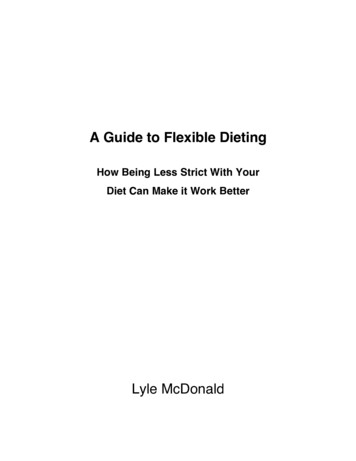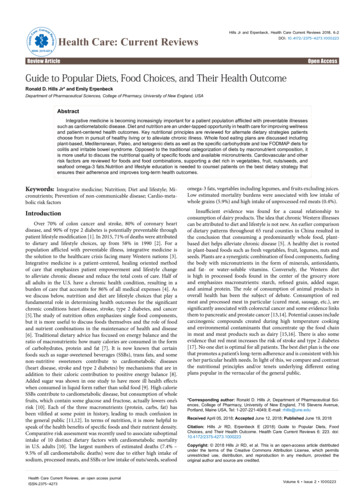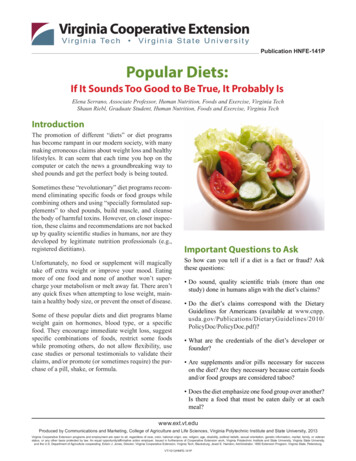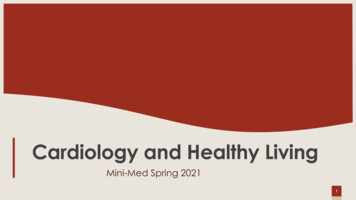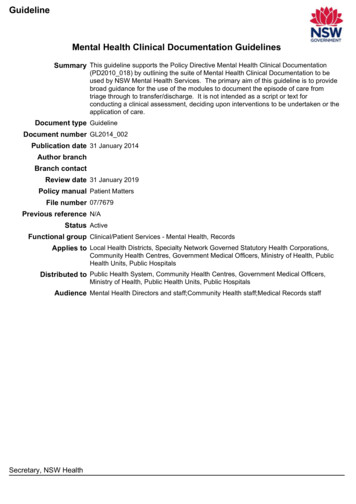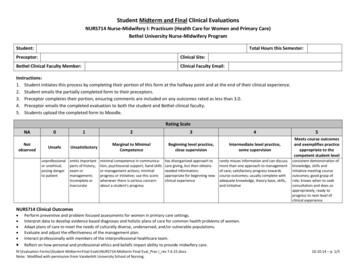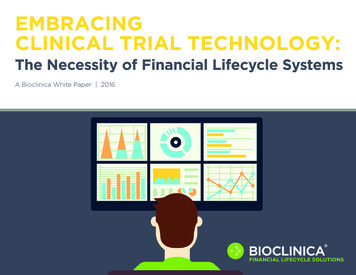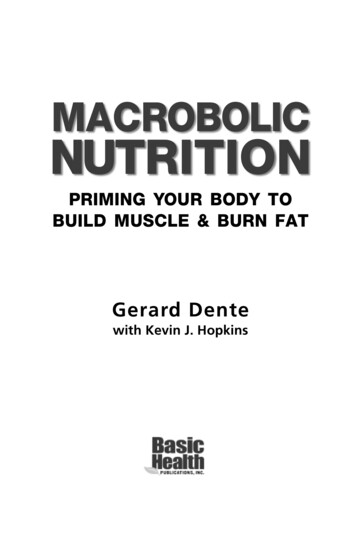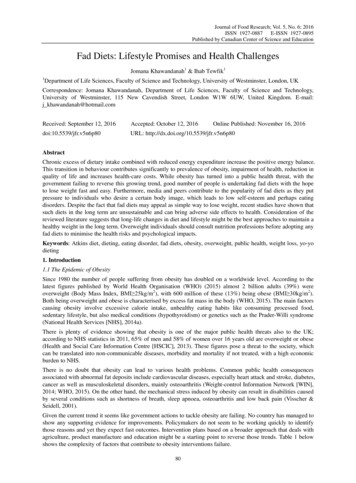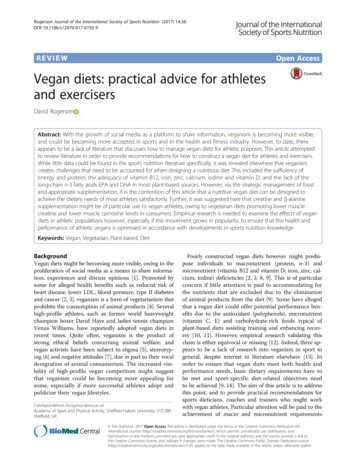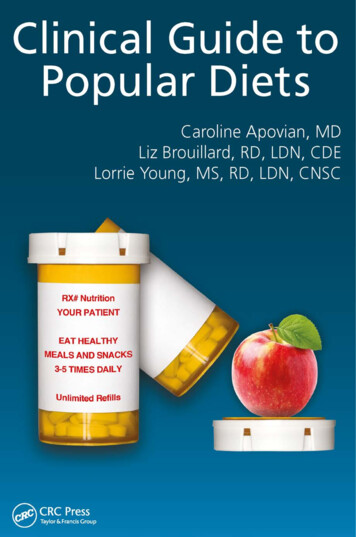
Transcription
Clinical Guide toPopular Diets
Clinical Guide toPopular DietsEdited byCaroline ApovianElizabeth BrouillardLorraine Young
Cover design concept created by Mary-Catherine Stockman, RD, LDNCRC PressTaylor & Francis Group6000 Broken Sound Parkway NW, Suite 300Boca Raton, FL 33487-2742 2018 by Taylor & Francis Group, LLCCRC Press is an imprint of Taylor & Francis Group, an Informa businessNo claim to original U.S. Government worksPrinted on acid-free paperInternational Standard Book Number-13: 978-1-4987-7430-7 (Paperback)978-0-8153-8104-4 (Hardback)This book contains information obtained from authentic and highly regarded sources. Reasonableefforts have been made to publish reliable data and information, but the author and publisher cannot assume responsibility for the validity of all materials or the consequences of their use. Theauthors and publishers have attempted to trace the copyright holders of all material reproduced inthis publication and apologize to copyright holders if permission to publish in this form has not beenobtained. If any copyright material has not been acknowledged please write and let us know so wemay rectify in any future reprint.Except as permitted under U.S. Copyright Law, no part of this book may be reprinted, reproduced,transmitted, or utilized in any form by any electronic, mechanical, or other means, now known orhereafter invented, including photocopying, microfilming, and recording, or in any informationstorage or retrieval system, without written permission from the publishers.For permission to photocopy or use material electronically from this work, please access www. copyright.com (http://www.copyright.com/) or contact the Copyright Clearance Center, Inc. (CCC),222 Rosewood Drive, Danvers, MA 01923, 978-750-8400. CCC is a not-for-profit organization thatprovides licenses and registration for a variety of users. For organizations that have been granted aphotocopy license by the CCC, a separate system of payment has been arranged.Trademark Notice: Product or corporate names may be trademarks or registered trademarks, andare used only for identification and explanation without intent to infringe.Library of Congress Cataloging–in–Publication DataNames: Apovian, Caroline M., editor. Brouillard, Elizabeth, editor. Young, Lorraine (Physician), editor.Title: Clinical guide to popular diets / [edited by] Caroline Apovian,Elizabeth Brouillard & Lorraine Young.Other titles: Popular dietsDescription: Boca Raton : CRC Press, Taylor & Francis Group, 2018.Identifiers: LCCN 2017048956 ISBN 9781498774307 (pbk.)Subjects: LCSH: Reducing diets--Evaluation.Classification: LCC RM222.2 .C51945 2018 DDC 613.2/5--dc23LC record available at https://lccn.loc.gov/2017048956Visit the Taylor & Francis Web site athttp://www.taylorandfrancis.comand the CRC Press Web site athttp://www.crcpress.com
hapter 1The Atkins Diet. 1Laura E. Matarese and Glenn K. HarvinChapter 2DASH Diet. 15Thomas J. Moore, Megan Murphy, and Lin Pao-HwaChapter 3iDiet. 35Susan B. Roberts, Amy Krauss, Madeleine M. Gamache,and Sai Krupa DasChapter 4The Mediterranean Diet. 53Sally M. CohenChapter 5The Paleo Diet. 71Laura AndromalosChapter 6The South Beach Diet. 87Meghan AriagnoChapter 7Vegan Diets.99Sai Krupa Das, Micaela C. Karlsen, Caroline Blanchard,and Susan B. RobertsChapter 8The Weight Watchers Diet. 113Megan BarnettChapter 9The Zone Diet. 127Catherine FanningIndex. 141v
IntroductionAs most clinicians know obesity rates continue to rise, with the most recent NHANESdata, from 2011–2014, indicating that 36.5% of US adults are considered obese.1 Thehealth risks of obesity are well researched and documented, including type 2 diabetes, cardiovascular disease, hypertension, stroke, gallbladder disease, osteoarthritis,sleep apnea, and some types of cancer.2 Modest weight loss of 5%–10% has beenshown to significantly improve obesity-related conditions.3 The physiology behindobtaining this weight loss is a negative energy balance, however, the diet macronutrient composition for the best results is still debated. The American Heart Association,American College of Cardiology, and The Obesity Society performed a systemicreview of the literature and found that of the 17 diets with varying macronutrientcomposition that have been studied, no diet was superior for weight loss or weightmaintenance. However, the biggest predictor of weight loss was determined to beadherence to a diet.2 As a clinician, many patients may look to you to recommenda diet program. Since no one diet has demonstrated superiority, it is important tounderstand the available diet plans on the market in order to guide your patients tothe diet right for them; one they will be able to incorporate into their lifestyle forlong-term success.This book will provide you with a non-biased review of several popular diets thathave been available and marketed for many years. The diets in this review includeThe Atkins Diet, The DASH (Dietary Approaches to Stop Hypertension) Diet, theiDiet, the Mediterranean Diet, Paleo Diets, South Beach Diet, vegetarian diets,Weight Watchers, and the Zone Diet. Each chapter will give you an overview of thediet, explain how the diet works, provide current research, illustrate typical results,list the pros and cons of the diet, and suggest patients that would benefit most fromeach diet. Our goal with this book is to assist you in guiding your patients to choosea diet that is most appropriate for them and one they will be able to follow for longterm results.REFERENCES1. Centers for Disease Control and Prevention (CDC). National Center for Health Statistics(NCHS). National Health and Nutrition Examination Survey Data. Hyattsville, MD:U.S. Department of Health and Human Services, Centers for Disease Control andPrevention; 2016. https://www.cdc.gov/nchs/data/factsheets/factsheet nhanes.htm2. Jensen M, Ryan D. et al. 2013 AHA/ACC/TOS guideline for the management of overweight and obesity in adults. A report of the American College of Cardiology/AmericanHeart Association. J AM Coll Cardiol 2014;63(25):2985–3023.3. National Institutes of Health, National Heart, Lung, and Blood Institute. ObesityEducation Initiative. Clinical guidelines on the identification, evaluation, and treatmentof overweight and obesity in adults. Obes Res 1998;6(Suppl 2):51S–210S.vii
EditorsCaroline Apovian, MD, FACP, DABOM, is professor of Medicine and Pediatrics,in the Section of Endocrinology, Diabetes, and Nutrition at Boston UniversitySchool of Medicine, USA. She is also director of the Center for Nutrition and WeightManagement at Boston Medical Center, USA. Dr. Apovian is a nationally and internationally recognized authority on Nutrition and Obesity Medicine and has been inthe field of Obesity and Nutrition since 1990. Her current research interests are in:weight loss and its effects on endothelial cell function obesity and cardiovasculardisease, adipose cell metabolism and inflammation, resolution of diabetes and cardiovascular disease in the bariatric surgery population, disparities in the treatmentof obesity in underserved populations, and novel pharmacotherapeutic anti-obesityagents. She is also an expert in the technique for subcutaneous adipose tissue biopsies, and has been studying the relationship between adipose tissue inflammation andobesity for over 10 years. Dr. Apovian was a member of the expert panel for updatingthe 2013 AHA/ACC/TOS Clinical Guidelines for the Management of Overweightand Obesity in Adults, published in Circulation and Obesity journals and was theChair of the Endocrine Society guidelines for Medical Treatment of Obesity published in the Journal of Endocrinology and Metabolism in 2015.Dr. Apovian was a recipient of the Physician Nutrition Specialist Award givenby the American Society of Clinical Nutrition. This was for her work on developingand providing nutrition education to medical students and physicians in training atBoston University School of Medicine. She has published over 200 original peerreviewed articles, chapters, and reviews on the topics of: obesity, nutrition, and therelationship between adipose tissue and risk of developing cardiovascular disease.Dr. Apovian has given over 150 invited lectures nationally and internationally andcurrently serves as President Elect of The Obesity Society (TOS) for 2016-17.Elizabeth Brouillard, RD, LDN, CDE, is the Nutrition Manager for The Centerof Endocrinology, Diabetes, Nutrition and Weight Management at Boston MedicalCenter. She completed her dietetic degree at the University of Maryland and wentto New Presbyterian Hospital for her clinical internship. She has been a registereddietitian for 10 years and has focused most of her career on weight management anddiabetes. She obtained a certificate in adult weight management from the Academyfor Nutrition and Dietetic and is a Certified Diabetes Educator. Elizabeth works inoutpatient settings and sees patients every day struggle to make diet and lifestylechanges for weight loss and glycemic control. Many of her patients have tried severaldifferent diets with varying success in the past and Elizabeth has been able to workwith these patients to determine which diet plan will work best for them based ontheir current health, lifestyle, and food preferences.Lorraine Young, RD, MS, CNSC, LDN, is the Clinical Nutrition Manager (CNM)and Home Nutrition Support Dietitian at Boston Medical Center (BMC). This position is part of the Department of Endocrinology, Diabetes and Nutrition. She is alsoix
xEditorsan Instructor of Medicine at Boston University School of Medicine. She is responsiblefor the management of all in-patient Clinical Nutrition Services and dietitians for bothadult and pediatric patients as well as two pediatric outpatient dietitians. Clinically,she manages all home parenteral and complex enteral patients discharged from thehospital or referred to the Endocrinology, Diabetes and Nutrition Department, whichincludes many short bowel patients and patients with Inflammatory Bowel Disease.She has over 35 years of experience in the field of Nutrition Support as well asin conducting clinical research with one of the original developers of parenteralnutrition in the United States. These research projects included work with intravenous and enteral glutamine and growth hormone in critically ill patients. She alsomanages complex bariatric surgery patients who may have developed complicationsand may require specialized nutrition therapies. She is a co-investigator on an NIHfunded R21 to study the Effects of Metabolic Support immediately post-trauma withDr. Peter Burke, Director of BMC’s Trauma Center. She has been involved as a consultant in an International Research Program with AFINS project (Abbott Fund inNutritional Sciences) whose goal is to improve inpatient Clinical Nutrition Servicesin Vietnam. She has published extensively with over 50 publications in the clinical nutrition field. She was the first recipient of the Dietitian’s in Nutrition SupportResearch Award and was also a recipient of the Massachusetts Young DietitianAward in the 1980s. As the CNM at the hospital, she also serves as a teacher, lecturer, and mentor to the hospital nutrition and medical staff.
ContributorsLaura AndromalosClinical NutritionVirginia Mason Medical CenterSeattle, WashingtonMeghan AriagnoGeneral and GI SurgeryBrigham and Women’s HospitalBoston, MassachusettsMegan BarnettDepartment of Endocrinology, WeightManagement, and NutritionBoston Medical CenterBoston, MassachusettsGlenn K. HarvinDivision of Gastroenterology,Hepatology and NutritionBrody School of MedicineEast Carolina UniversityGreenville, North CarolinaMicaela C. KarlsenNutritional EpidemiologyLaboratoryJean Mayer USDA Human NutritionCenter on AgingTufts UniversityBoston, MassachusettsCaroline BlanchardEnergy Metabolism LaboratoryJean Mayer USDA Human NutritionCenter on AgingTufts UniversityBoston, MassachusettsAmy KraussEnergy Metabolism LaboratoryJean Mayer USDA Human NutritionCenter on AgingTufts UniversityBoston, MassachusettsSai Krupa DasEnergy Metabolism LaboratoryJean Mayer USDA Human NutritionCenter on AgingTufts UniversityBoston, MassachusettsLaura E. MatareseDivision of Gastroenterology,Hepatology and NutritionBrody School of MedicineEast Carolina UniversityGreenville, North CarolinaCatherine FanningNutrition Boston Medical CenterBoston, MassachusettsMadeleine M. GamacheEnergy Metabolism LaboratoryJean Mayer USDA Human NutritionCenter on AgingTufts UniversityBoston, MassachusettsThomas J. MooreBoston University School ofMedicineUniversity in BostonBoston, MassachusettsMegan Murphye-Havior Change, LLCWaban, Massachusettsxi
xiiLin Pao-HwaDepartment of MedicineNephrology DivisionDuke University MedicalCenterDurham, North CarolinaContributorsSusan B. RobertsEnergy Metabolism LaboratoryJean Mayer USDA Human NutritionCenter on AgingTufts UniversityBoston, Massachusetts
1The Atkins DietLaura E. Matarese and Glenn K. HarvinCONTENTSOverview. 1How the Diet Works. 1The Atkins Plan. 2Current Research. 6Effects of Carbohydrate Restriction for Individuals with Type 2 Diabetesand Metabolic Syndrome. 6Effects of Carbohydrate Restriction on Cardiovascular Disease. 8Weight Loss, Compliance, and Recidivism. 9Typical Results. 10Pros and Cons. 10Is This Diet Right for You?. 11Conclusion. 11References. 11OVERVIEWDespite the fact that there are well over 1000 published weight-loss diets in the lay literature, few have attracted as much attention as the Atkins Diet. The late Dr. RobertC. Atkins developed this low-carbohydrate, high-protein weight-loss plan which waspublicized in his best-selling book, The Atkins Diet Revolution.1 Dr. Atkins promotedthe plan as not only a quick weight-loss diet but as a change in eating for a lifetime.The diet was extremely popular allowing individuals to consume large quantities ofmeat and high-fat foods without considering caloric restrictions. Critics referred tothe diet as a high-protein, high-fat, low-carbohydrate ketogenic diet which could bepotentially harmful. Early claims on both sides were often fueled by perception andpersonal biases without scientific evidence. Eventually, the emergence of numerousclinical trials appeared in the scientific literature demonstrating the efficacy andsafety of the Atkins Diet.HOW THE DIET WORKSHistorically, obesity has been considered to be a result of an imbalance in caloricintake versus expenditure. The idea was simple: when individuals take in more calories than they expend, the result will be weight gain. Given the growing incidence of1
2Clinical Guide to Popular Dietsobesity worldwide, however, it has become clear that this represents an over-simplification of a complex disease whose cure is more complicated than simply creatinga caloric deficit. Physiologically, carbohydrate restriction, as opposed to a negativeenergy balance, is responsible for initiating the metabolic response to fasting.2 TheAtkins hypothesis is that dietary carbohydrate, particularly from simple sugars,causes hyperinsulinemia, leading to insulin resistance, obesity, and the metabolicsyndrome. Excess carbohydrate prevents effective lipolysis with resulting lipogenesis. Low carbohydrate diets reduce the dietary contribution to serum glucose therebylowering insulin levels. Insulin is a potent stimulator of lipogenesis and inhibitor oflipolysis. Lowering insulin levels allows the utilization of stored body fat for energy.Severe carbohydrate restriction leads to a progressive depletion of glycogen storeseventually switching metabolism to lipolysis. With a reduction in dietary carbohydrate, there is a corresponding increase in dietary protein and fat. This leads to theproduction of ketones which act as an appetite suppressant and contribute to an overall voluntary caloric reduction.3,4 It has been proposed that inefficient protein and fatoxidation leads to additional energy loss since more adenosine triphosphate (ATP)is required to oxidize these macronutrients.5 Lipolysis is maintained despite excesscalories because glycerol from fat is needed as a gluconeogenic precursor.2 The carbohydrate level required to produce the metabolic shift from lipogenesis to lipolysishas been debated, but it is thought to be between 20 and 50 g of carbohydrate per dayin the initial phases of the diet. This contrasts sharply with the typical carbohydratecontent of the Western diet which often exceeds 300 g per day comprising largequantities of simple, rapidly hydrolyzed carbohydrates.THE ATKINS PLANThe foundation of the Atkins Plan is a reduction of carbohydrates. The diet hasevolved over the years to currently offer two options (Table 1.1). With Atkins 20 ,the starting point (Phase 1, Induction) is 20 g of “Net Carbs” (carbohydrate minusgrams of fiber) per day. The Atkins 40 allows a starting point of 40 g of Net Carbsper day. Both plans allow for an increase in carbohydrates. One plan adds foods oneat a time and the other raises the carbohydrate portion-size allowance as individualsapproach their weight loss goals (Table 1.1).The Atkins 20TM (the original plan) includes a four-step process beginning witha two-week induction phase with carbohydrates restricted to 20 g Net Carbs per day(Table 1.2). The carbohydrates are derived primarily from low-glycemic, nutrientdense, fiber-rich carbohydrates such as leafy green salads and other non-starchyvegetables. The client is instructed to consume 4–6 oz. of protein at each meal andenough natural fat to feel satiated. Trans fats are eliminated. The protein is derivedfrom a variety of sources to include meat, fish, poultry, eggs, and vegetable-basedproteins such as tofu. Adequate fluid (water preferred) intake along with exerciseand a complete multivitamin/mineral supplement is recommended in order to obtainoptimal nutrition. Dairy intake is limited because of its carbohydrate content, therefore, calcium supplementation is recommended.The second phase of the program is referred to as the ongoing weight lossphase. During this phase, carbohydrates are added into the diet in the form of
3The Atkins DietTABLE 1.1Comparison of the Atkins Diet PlansAtkins 20TMAtkins 40TMInitial Phase of Weight LossNet carbs (grams)ProteinHealthy fatsCarbohydratesPhase 2 of weightloss increasingcarbohydrates203 servings of 4–6 oz per serving3 servings of added healthy fats perday, e.g., butter, salad dressings, oliveoil, etc.Limited—Most carbs are derived fromvegetables during first 2 weeks, e.g.,leafy greens and other low-carbvegetablesDairy foods high in fat and low incarbs: cream, sour cream, and mosthard cheeses are allowedAdd in 5 g net carb increments startingwith lower carb foods and graduallyprogressing to higher carb foods Nuts and seeds (but not chestnuts) Berries, cherries, and melon (butnot watermelon) Whole milk yogurt and freshcheeses, such as cottage cheeseand ricotta Legumes, including chickpeas,lentils, and the like Tomato and vegetable juice“cocktail” Other fruits (but not fruit juices ordried fruits) Higher-carb vegetables, such aswinter squash, carrots, and peasAdding foods backinto the dietProteinHealthy fatsIncreasingcarbohydratesWeight Maintenance PhaseProgressive—Carbohydrates are slowlyadded back into the diet3 servings of 4–6 oz per serving3 servings of added healthy fats perday, e.g., butter, salad dressings, oliveoil, etc.Carbohydrates are added back in 5 gnet carb increments until weightstabilizes. That carb intake iscontinued to maintain weight403 servings of 4–6 oz per serving3 servings of added healthy fatsper day, e.g., butter, saladdressings, olive oil, etc.All Food Groups—About 1/3carbs from vegetables, remainingcarbs from fruit, nuts, and/orwhole grainsAdd 10 g of net carbs whenindividual is within 10 pounds ofgoal weight by increasing servingsize or adding more variety10 g of net carbs may be addedeach week as long as weight losscontinues. Continue to use thesame acceptable foods listAll Food Groups—The acceptablefoods list remains the same untilgoal weight is achieved3 servings of 4–6 oz per serving3 servings of added healthy fatsper day, e.g., butter, saladdressings, olive oil, etc.Carbohydrates are added back in10 g net carb increments untilweight stabilizes. That carb intakeis continued to maintain weight
4Clinical Guide to Popular DietsTABLE 1.2Example Menu for Atkins 20TMBreakfastNetCarbs (g)Phase 1—InductionNet carbs 20 g/day2 scrambled eggs (with milk)2.01/2 medium tomato1/2 Haas avocadoCoffee/teaSnackString Cheese, 1 oz.Cucumber, 1/2 cupLunch1 cup mixed greensGrilled chickenCaesar DressingCoffee/tea/water/diet sodaSnack2 celery stalksCreamy Italian dressingCoffee/tea/water/diet sodaDinnerGrilled salmonSteamed broccoli (1/2 cup)Arugula salad (1 cup)Coffee/tea/water/diet sodaTotal net carbs2.01.50Phase 2—Ongoing Weight LossNet carbs start at 25 g/day gradually increasingYellow squash and Gruyere frittataintake in 5 g increments each week or everyseveral weeks until weight loss ceases orbegins to slow. Net carb prescription is thenreduced by 5 g.Coffee/teaSnack2 tablespoons oil roasted mixed nutsCoffee/tea/water/diet sodaLunchCanned tuna1/4 cup red bell pepper1/2 medium tomatoCoffee/tea/water/diet sodaSnack4 oz. whole milk Greek yogurt1/2 cup fresh .0001.52.006.13.3(Continued)
5The Atkins DietTABLE 1.2 (Continued)Example Menu for Atkins 20TMBreakfastDinnerFlank steakGrilled asparagus (6)1 cup Romaine hearts2 tablespoons Green Goddess dressing1/2 cup fresh raspberriesTotal net carbsPhase 3—Pre-MaintenanceCarbohydrate intake increased by 10-gramTotal net carbsincrements every week to maintain verygradual weight loss, generally half a pound aweek. Once the goal weight is achieved, theindividual remains at that carbohydrateintake level until body weight stabilizes forone month.Phase 4—Lifetime MaintenanceEmphasis on sustainable changes to lifestyle inTotal net carbsorder to maintain the weight loss. Individualscontinue to eat the same variety of foods as inthe last month of Pre-Maintenance, whilecontrolling carbohydrate intake to ensureweight maintenance. Since body fat is nolonger the primary source of energy, a slightlygreater intake of natural fats is necessary tomaintain weight.NetCarbs , fiber-rich foods increasing to 25 g of Net Carbs per day duringthe first week. The carbohydrate content is further increased each week or everyseveral weeks in 5-gram increments until weight loss ceases or begins to slow. Atthis point, the Net Carb prescription is reduced by 5 g. The individual remains atthis level for a sustained, moderate weight loss, generally averaging one to twopounds per week.Phase three is “Pre-Maintenance,” which transitions the individual from weightloss to weight maintenance by increasing daily carbohydrate intake in 10-gramincrements every week for several weeks to maintain very gradual weight loss, generally half a pound a week. Once the goal weight is achieved, the individual remainsat that carbohydrate intake level until body weight stabilizes for one month.The final phase is referred to as “Lifetime Maintenance.” Emphasis is placed onsustainable lifestyle changes in order to maintain the lower weight. Individuals continue to eat the same variety of foods as in the last month of Pre-Maintenance while
6Clinical Guide to Popular Dietscontrolling carbohydrate intake to ensure weight maintenance. A slight increasedintake of natural fats is necessary to maintain the lower weight since body fat is nolonger the primary source of energy.Over the years, the diet has evolved to emphasize healthy protein and fat choicesfrom a variety of foods. Vegetables are included in every phase of the Atkins program including the most restrictive induction phase. As an individual progressesthrough the diet phases, ingestion of more vegetables along with low-glycemic fruits,nuts, seeds, whole grains, and legumes is encouraged. Later versions of the originalAtkins Diet acknowledged that exercise is important for weight loss and maintenance as well as for achieving overall health benefits.CURRENT RESEARCHDesigning controlled trials to evaluate the safety and efficacy of dietary interventions is challenging. Randomization of interventions is possible, but blinding isdifficult. Results may vary depending on whether the study was conducted as anoutpatient in a “free-living” environment versus a controlled metabolic inpatientsetting. The study population may not always be homogenous in terms of the disease process, comorbidities, age, gender, body mass index (BMI), and medications.Adherence to a dietary intervention is not always optimal, making interpretation ofthe results difficult. Outcome parameters vary considerably and many are poorlydefined. For example, it may be debated whether weight loss alone is an adequateoutcome parameter or whether it is more important to look at changes in risk factorsfor disease and medication requirements. Many studies were underpowered, short induration, or had high dropout rates, leading investigators to perform meta-analyses.There is a significant body of literature despite these challenges that has evaluatedthe low-carbohydrate Atkins Plan. Many of the studies evaluated the “low carbohydrate” concept, but the actual study design may or may not necessarily follow the“Atkins Diet.” For the purpose of this review, all studies evaluating low carbohydratediets are considered to be indicative of the Atkins Diet. Effects of Carbohydrate Restriction for Individualswith Type 2 Diabetes and Metabolic SyndromeDiabetes is a disease of altered carbohydrate metabolism. There are a number offactors which increase the risk of type 2 diabetes. Individuals who are overweightor obese, especially central obesity, can have insulin resistance. Obesity, in addition to high blood pressure, high cholesterol, and triglycerides, results in metabolicsyndrome. It is logical to assume that reduction of dietary carbohydrate content mayresult in better glucose management and weight loss.Feinman and colleagues’ systematic review concluded that dietary carbohydraterestriction should be the first approach in diabetes management.5 Restriction of dietarycarbohydrate consistently reduces elevated blood glucose independent of weight loss,and reduces the requirement of medications to control blood sugar such as insulin.There is also evidence that improved glucose concentrations, weight loss, and lipidprofiles reduce the cardiovascular risk seen in individuals with type 2 diabetes.
The Atkins Diet7If dietary carbohydrate restriction is beneficial for individuals with type 2 diabetes, what is the optimal level of restriction to achieve these beneficial effects?Westman and colleagues randomized 84 subjects with obesity and type 2 diabetes toreceive either a low-carbohydrate, ketogenic diet or a low-glycemic index diet overa 24-week trial.6 The low-carbohydrate group lost more weight (11.1 kg) comparedto the low-glycemic group (6.9 kg). The hemoglobin A1c was reduced by 1.5% inthe low-carbohydrate group compared to 0.5% in the low-glycemic group. Diabetesmedications were either reduced or eliminated in 95.2% of the low-carbohydrategroup compared to 62% in the low-glycemic group, and only the low-carbohydrategroup achieved an increase in high-density lipoprotein (HDL) cholesterol.Since individuals with diabetes often have significant cardiovascular risk profiles, Tay and colleagues compared the effects of a very-low-carbohydrate, highunsaturated fat, low-saturated fat (LC) diet with a high-car
iDiet, the Mediterranean Diet, Paleo Diets, South Beach Diet, vegetarian diets, Weight Watchers, and the Zone Diet. Each chapter will give you an overview of the diet, explain how the diet works, provide current research, illustrate typical results, list the pros and cons of the diet, and suggest patients
